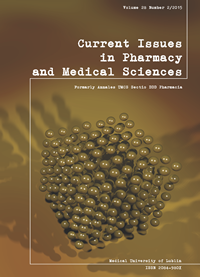The knowledge of pregnant women regarding appropriate oral hygiene practices of young children – a questionnaire survey
DOI:
https://doi.org/10.1515/cipms-2015-0050Keywords:
pregnant women, early childhood caries, caries prophylaxisAbstract
Maintaining appropriate oral cavity hygiene in a young child is closely related to the health awareness and health-promoting behaviours of their parents/guardians, and especially that of the child’s mother. The aim of the study was to evaluate the knowledge of pregnant women regarding best practice oral hygiene procedures in young children. The survey involved 327 pregnant women aged 16-49 years, and the tool utilized was an anonymous questionnaire survey. The questionnaire included seven one-choice questions concerning basic information on proper oral hygiene procedures as should be practiced by young children. The statistical analysis was performed using Statistica PROGRAM 10 (StatSoft). The results of the survey reveal 60.55% of all surveyed had correct knowledge with regard to appropriate cleaning practices for the toothless oral cavity of an infant, that concerning the beginning of tooth brushing - 70.03%, tooth cleaning after night feeding - 39.76%, the duration of tooth brushing (at least 3-4 minutes) - 43.12%. What is more, the result of the survey demonstrate that slightly more than a half of the surveyed mothers (53.82%) would encourage their children to brush their teeth on their own from the first year of age, while 18.35% believe that children should be assisted in tooth brushing at least to their eighth year of age, and 59.63% would use fluoride toothpaste to brush their child’s teeth before he or she is one year old. Of the participants in this survey, pregnant women with university education, those living in large cities, or who are older, and those who had had previous pregnancies, show greater knowledge regarding suitable oral hygiene practices among young children. Our results reveal that extensive application of modern information technologies can be a means of preventing early childhood caries by facilitating the transmission of knowledge on proper nutrition and oral hygiene practices among young children.
References
1. Ciok E., Grzebyta A., Maciejak D., Zadurska M.: Awareness of prophylaxis of disorders in stomatognathic system among pregnant women. Nowa Stomatologia, 18, 12, 2013.
2. Clifford H., Johnson N.W., Brown C., Battistutta D: When can oral health education begin? Relative effectiveness of three oral health education strategies starting pre-partum. Community Dent. Health., 29, 162, 2012.
3. European Academy of Paediatric Dentistry: Guidelines on the use of fluoride in children: an EAPD policy document. Eur. Arch. Paediatr. Dent., 10, 129, 2009.
4. Harris R., Nicoll A.D., Adair P.M., Pine C.M.: Risk factors for dental caries in young children: a systematic review of the literature. Community Dent. Health., 21(suppl 10), 71, 2004.
5. Iwanicka-Grzegorek E., Paluch M.: Knowledge about oral disease prevention of pregnant women – part II. Dental care of infant. Stomatol. Współcz., 18, 10, 2012.
6. Janas S., Olczak-Kowalczyk D., Wysocka M.: Rola lekarzy niestomatologów w zapobieganiu próchnicy wczesnego dzieciństwa. Nowa Pediatria, 1, 6, 2011.
7. Jiang E.M., Lo E.C., Chu C.H., Wong M.C.: Prevention of early childhood caries (ECC) through parental toothbrushing training and fluoride varnish application: a 24-month randomized controlled trial, J. Dent., 42, 1543, 2014. [CrossRef] [Web of Science]
8. Manchanda K., Sampath N., Sarkar A.D.: Evaluating the effectiveness of oral health education program among mothers with 6-18 months children in prevention of early childhood caries. Contemp. Clin. Dent., 5, 478, 2014. [PubMed]
9. Plutzer K., Keirse M.J.N.: Influence of an intervention to prevent early childhood caries initiated before birth on children’s use of dental services up to 7 years of age. Open Dent. J., 8, 104, 2014.
10. Pypeć J., Rogalska A., Zieleniewicz K., Mikołajczyk M.: Pregnant women’s knowledge about prophylaxis of caries in children. Questionnaire. Przegl. Pediatr., 35, 211, 2005.
11. Ramos-Gomez F.: Early maternal exposure to children’s oral health may be correlated with lower early childhood caries prevalence in their children. J. Evid. Based Dent. Pract., 12(suppl 13), 29, 2012.
12. Stanisz A. (2006). Przystępny kurs statystyki z zastosowaniem STATISTICA PL na przykładach z medycyny. Tom 1. Statystyki podstawowe. Kraków: Statsoft Polska.
13. Starczewska M., Emerich K.: Dental prophylaxis in children. Nowa Pediatr., 13, 28, 2010.
14. Szczepańska J., Szydłowska B., Lubowiedzka B. Pawłowska E.: Analiza czynników ryzyka występowania choroby próchnicowej u 3-letnich dzieci. Czas. Stomatol., 60, 162, 2007.
15. Tkaczuk M., Wiercioch-Klin B., Szymańska J.: Dobowa analiza żywienia dzieci z uwzględnieniem kariogenności stosowanych produktów spożywczych. Med. Ogól. Nauk Zdr., 18, 448, 2012.
16. Turska-Szybka A., Grudziąż-Sękowska J., Olczak-Kowalczyk D.: Czynniki ryzyka próchnicy wczesnego dzieciństwa i indywidualna ocena poziomu ryzyka na podstawie CAMBRA. Nowa Stomatologia, 3, 119, 2011.
17. Weber-Gasparoni K. et al: An effective psychoeducational intervention for early childhood caries prevention: Part II. Pediatr. Dent., 35, 247, 2013.
18. Wierzbicka M. et al.: Ogólnopolski Monitoring Zdrowia Jamy Ustnej i Jego Uwarunkowań. 2002. Ministerstwo Zdrowia 2003.
Downloads
Published
Issue
Section
License
Copyright (c) 2015 Authors

This work is licensed under a Creative Commons Attribution-NonCommercial-NoDerivatives 3.0 Unported License.


